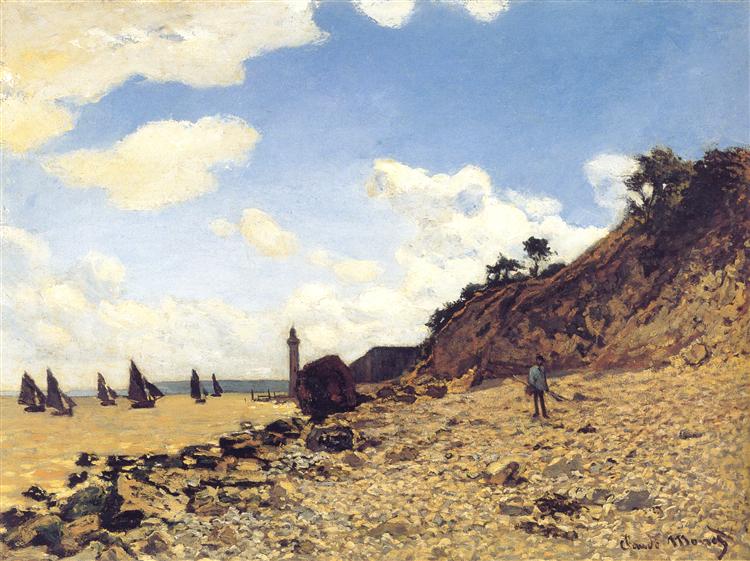Description
Claude Monet's painting "The Beach at Honfleur", painted in 1866, is a work that encapsulates the essence of the Impressionist movement, while revealing the artist's unique approach to landscape and light. The work depicts a view of the beach in the French town of Honfleur, a place that Monet frequented and which became a source of inspiration for many artists of his time. In this work, Monet is faced with the task of capturing the changing effect of light on water and sand, a recurring theme in his career.
The artistic composition of "The Beach at Honfleur" focuses on an open and expansive landscape that invites the viewer to enter the scene. The horizon is situated in the distance, while the beach and coastline dominate the foreground, creating a sense of depth. The loose and rapid application of paint is characteristic of Monet's style, who sought to capture on canvas not only the shapes, but also the sensations that a landscape can evoke. The structure of the work is built from quick and vibrant brushstrokes that shape the waves of the sea and the sand, suggesting movement and dynamism.
The use of color in The Beach at Honfleur is equally notable. Monet combines a palette of blues, greens, yellows and beiges, creating a contrast that brings freshness to the scene. The blues of the sea are complemented by the golds and ochres of the sand, while the shadows cast by the human figures add a nuance of emotional complexity. The way the colors intertwine across the surface of the canvas is a testament to Monet's deep understanding of color theory and how different hues link together to create the desired atmosphere.
In the work, some characters are visible on the beach, although they are represented with an almost schematic and suggestive approach. Monet's technique tends to soften the details of the individuals, who appear as silhouettes in their surroundings, thus emphasizing the dialogue between the human figure and the vastness of nature. This approach not only highlights the insignificance of the human being in the face of the natural landscape, but also underlines the artist's interest in capturing ephemeral moments and in the interaction of light with the environment.
It is interesting to note that the context of the work is set in a time when Monet was exploring the viability of a style that deviated from traditional academic norms. The Beach at Honfleur is an emblematic piece of this period when Monet began to establish his identity as one of the precursors of Impressionism, a movement that was in its early stages. This work, in particular, reflects Monet's desire to study nature in its purest state, a desire that would become the hallmark of his career.
Ultimately, The Beach at Honfleur is not only a testament to Monet’s talent, but also an invitation to contemplate the relationship between man, the sea and light. Through his mastery of color and form, Monet transports us to a specific moment in time, capturing the essence of the Honfleur landscape and offering an introspective view of nature and its ceaseless change. The work remains a significant example of the evolution of Impressionism and continues to resonate with contemporary audiences, reminding us of the beauty in the simplicity of the lived moment.
KUADROS ©, a famous painting on your wall.
Hand-made oil painting reproductions, with the quality of professional artists and the distinctive seal of KUADROS ©.
Painting reproduction service with satisfaction guarantee. If you are not completely satisfied with the replica of your painting, we will refund 100% of your money.

